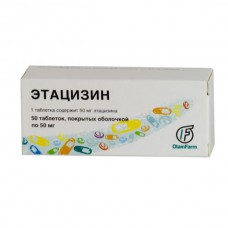Expiration date: 05/2026
Composition and form of issue:
Tablets, film-coated. 1 tablet contains:
active substance:
Ethacyzin (diethylaminopropionylethoxycarbonylaminophenothiazine hydrochloride) 50 mg
excipients: potato starch-9, 57 mg sucrose-19, 3 mg methylcellulose-0, 33 mg calcium stearate-0, 8 mg
the shell: sucrose — 37, 695 mg of povidone — 0, 753 mg quinoline yellow dye (E104) — 0, 025 mg of dye "sunset" yellow (E110) — 0, 003 mg calcium carbonate — 6, 308 mg of magnesium hydroxycarbonate primary — 3, 678 mg titanium dioxide (E171) — 0, 665 mg silicon dioxide — 0, 827 mg of Carnauba wax — a 0 046 mg
in the contour cell packaging of PVC film 10 PCs. in a pack of cardboard 5 packages.
Description of dosage form:
Round tablets, film-coated yellow color. Two layers are visible on the cross section.
Pharmacokinetics:
If ingestion is rapidly absorbed from the gastrointestinal tract and is determined in the blood after 30-60 min, Cmax in plasma is reached after 2, 5-3 hours Bioavailability of 40%. 90% is bound to plasma proteins. T1/2 is 2 5 h. the pharmacokinetic Parameters of Etazizina subject to significant individual fluctuations and require individual study individual patients to determine the optimal concentration of the drug in the blood plasma. Intensively metabolized by the "first pass" through the liver. Some of the resulting metabolites have antiarrhythmic activity. From the body Ethacyzin excreted by the kidneys in the form of metabolites. Ethacyzin crosses the placental barrier. Stands out with breast milk.
Description of pharmacological action:
Ethacyzin — antiarrhythmic drug of the IC class has a long-arrhythmic effect. Inhibits the rate of rise of the action potential front (Vmax), does not change the rest potential. Depending on the dose may reduce the duration of the action potential. Does not change significantly effective refractory periods of the ventricles and Atria. Inhibits fast incoming sodium current and, to a lesser extent, slow incoming calcium current.
Ethacyzin slows down the excitation of the conductive system of the myocardium. On the ECG there is an extension of the PR interval and the QRS complex ST interval, reflecting the repolarization of the ventricles, does not change or tends to shorten.
Ethacyzin increases the fibrillation threshold of the myocardium. Unlike many antiarrhythmic drugs Ethacyzin does not cause a significant decrease in heart rate or prolonging the duration of the QT interval on the ECG.
Antiarrhythmic effect when administered usually develops on the 1-2 th day, the duration of treatment depends on the form of arrhythmia, efficacy and tolerability of the drug.
Indications:
- supraventricular and ventricular premature beats
- paroxysms and flicker atrial flutter
- ventricular and supraventricular tachycardia, including wolf-Parkinson-white syndrome (WPW).
- Indications for use are limited to the presence of severe organic heart damage.
Contraindications:
- increased individual sensitivity to Etazizina or auxiliary substances
- severe conduction disorders (including sinoatrial blockade, AV blockade of II and III degree in the absence of an artificial rhythm driver), intraventricular conduction disorders
- severe left ventricular hypertrophy
- the presence of postinfarction cardiosclerosis
- cardiogenic shock
- severe hypotension
- chronic heart failure of functional class II and III
- severe liver and/or kidney dysfunction
- pregnancy
- lactation
- children (under 18 years) - efficacy and safety not established
- simultaneous administration of MAO inhibitors
- concurrent use of antiarrhythmic means IC (moracizin, propafenon, allapinin) and IA (quinidine, procainamide, disopyramide, ajmaline), class
- any form of cardiac arrhythmia combined with blockade of the GIS-Purkinje system.
With caution: the syndrome of weakness of sinus node, bradycardia, AV blockade of I degree, coronary artery disease, severe peripheral circulatory disorders, chronic heart failure FC, angle-closure glaucoma, benign prostatic hyperplasia, cardiomegaly (increased risk of developing arrhythmogenic action), violation of elektrolitnogo balance (hypokalemia, hyperkalemia, hypomagnesemia), hepatic/renal failure.
Side effect:
From the CCC: sinus node stop, AV blockade, violation of intraventricular conduction, reduction of myocardial contractility, reduction of coronary blood flow, arrhythmia (arrhythmogenic effect is most likely after myocardial infarction and other types of heart disease, leading to a decrease in the contractility of the heart muscle and the development of heart failure).
ECG changes: prolongation of the PQ interval, enlargement of P wave and QRS complex.
From the Central nervous system: dizziness, headache, shaking when walking or turning the head, slight drowsiness in some cases — diplopia, paresis of accommodation.
From the gastrointestinal tract: nausea.
It is possible to reduce side effects or their disappearance after the use of the drug for 3-4 days. With long-term treatment with Ethacyzin, they do not increase, and with the cessation of the drug quickly disappear.
Side effects depend on the size of the dose and to avoid them, you should not assign the maximum dose.
Drug interaction:
Do not use with other antiarrhythmic funds IC (moracizine, allapinina, propafenone) and IA (quinidine, procainamide, dizopiramid, aymalin) class.
Ethacyzin should not be administered simultaneously with MAO inhibitors.
The combination of beta-blockers with Etazizina may increase antiarrhythmic effect, especially against arrhythmia provoked by exercise or stress.
Dosage and administration:
Inside, regardless of the meal. Initial dose-50 mg (1 table.) 2-3 times a day. In case of insufficient clinical effect, the dose is increased (under mandatory ECG control) to 50 mg 4 times a day (200 mg) or 100 mg 3 times a day (300 mg).
Upon reaching a stable antiarrhythmic effect, supportive therapy is carried out in individually selected minimal effective doses.
Overdose:
Ethacyzin has a small therapeutic latitude, so it can easily be heavy intoxication (especially with the simultaneous use of other antiarrhythmic agents).
Symptoms: prolongation of PR intervals and expansion of QRS complex, increase in the amplitude of t wave, bradycardia, sinoatrial and AV blockade, asystole, paroxysm of polymorphic and monomorphic ventricular tachycardia, reduction of myocardial contractility, persistent decrease in blood PRESSURE, dizziness, blurred vision, headache, gastrointestinal disorders.
Treatment: symptomatic for the treatment of ventricular tachycardia should not be used antiarrhythmic agents IA and IS sodium class bicarbonate is able to eliminate the expansion of the complex QRS, bradycardia and hypotension.
Special instruction:
Like other antiarrhythmic drugs, Ethacyzin can act aritmogenne. So if you assign Ethacyzin should:
- strictly take into account contraindications to the use of the drug
- in advance to identify and correct hypokalemia
- avoid use in combination with anti-arrhythmic means, IA and IC classes
- course treatment is preferable to start in a hospital (especially in the first 3-5 days of drug administration, taking into account the dynamics of ECG after initial and repeated doses of Ethacyzin or ECG monitoring data)
- immediately stop treatment with increased frequency of ectopic ventricular complexes, blockages or bradycardia. Treatment with Ethacizin should also be stopped immediately with the expansion of ventricular complexes by more than 25%, a decrease in their amplitude, the duration of the p wave on the ECG is more than 0, 12 s.
Risk factors for arrhythmogenic action of Ethacizin are: organic heart damage (especially — suffered myocardial infarction), reduction of left ventricular ejection fraction, maximum doses of the drug. In addition, caution should be exercised in patients with liver diseases. In the treatment of Ethacizine can not drink alcohol.
During therapy, it is necessary to regularly monitor the patient's condition and CCC function (ECG, AD, echocardiography).
Influence on the ability to drive or perform work that requires increased speed of physical and mental reactions. Due to the risk of developing dizziness during treatment, it is not recommended to drive vehicles or maintain complex mechanisms that require increased attention and concentration.


